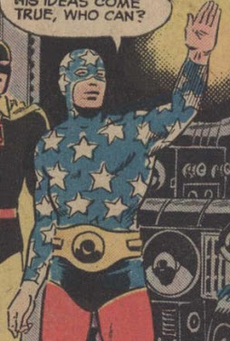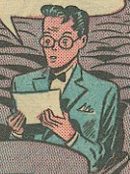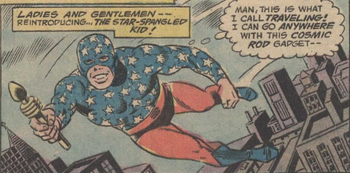| Continuity-Related Comic Book Character | |
| Star Spangled Kid | |
|---|---|

| |
| Information | |
| Real name: | Sylvester Pemberton |
| Species: | Human |
| Homeworld: | Earth |
| Universe: | Earth-2A |
| Base: | New York City |
| Affiliations: | Justice Society of America Super Squad Mystery-Men |
| Abilities: | Acrobatics |
Justice Society Team Member

Sylvester Pemberton as shown in Star Spangled Comics, #18 (March 1943).
Sylvester Pemberton was born in 1926. He is the son of wealthy banker Sylvester J. Pemberton[1] who became the Star-Spangled Kid in order to battle Nazism and fifth columnists during World War II. Sylverster had an adult sidekick, Stripesy a.k.a. Pat Dugan. Both he and Dugan were superb acrobats and trained in hand-to-hand combat. Together they built the Star Rocket Racer, a bubble-topped limousine with the functions of a rocket and helicopter. Sylvester was also a member of the Justice Society of America who teamed teamed up with the Justice League and the 30th century superhero team known as the Legion of Super-Heroes.

Background Information[]
In the parallel universe of Earth-Two (Earth-2A in the SuperFriends Universe), a young, wealthy Sylvester Pemberton was enamored with the silver screen. On one movie-going excursion, Pat Dugan (soon to be family mechanic and chauffer for the Pembertons) and the young Pemberton became involved in an all out brawl with pro-Nazi agents. Together they defeated the Nazi spies. Later that evening, Sylvester was getting his car fixed at Pat's garage. As the two talked, they overheard another customer discussing the riot at the theater and wishing out loud that the American flag could come to life and thrash such scum. The two were inspired to become mystery-men. Separately, the two created a uniform based on the American flag – Sylvester as the stars and Pat as the stripes. Pemberton took the code-name "Star-Spangled Kid" and Dugan took the name "Stripsey." After that they became partners, and Pat went to work as the Pemberton family chauffeur.[2]
Teaming up with several other heroes over the next few years, both the Star-Spangled Kid and Stripesy became founding members of the Seven Soldiers of Victory (also known as the Law's Legionnaires). In addition to Stripesy and the Star-Spangled Kid, the Soldiers of Victory consisted of the Vigilante, the Crimson Avenger, Sir Justin the Shining Knight and an Earth-Two version of Green Arrow and Speedy.[3]
Late in 1948, his parents felt that he needed more companionship, and adopted a young girl named Merry to be his playmate. She stumbled upon the Kid's secret and devised her own secret identity, as the Gimmick Girl and aided the Star-Spangled Kid in several cases while Stripesy healed from a broken leg.
In October, 1949, the Seven Soldiers of Victory engaged an alien conqueror called the Nebula-Man who was attempting to destroy the earth. A device that was designed to defeat the alien did result in the aliens defeat, but scattered the remaining members of the Seven Soldiers of Victory through time. The Star-Spangled Kid was hurled 50,000 years in the past. He was rescued a little more than 20 years later by the Justice League of America and the Justice Society of America.[4]
Sylvester was taken in, by a then-injured Starman who loaned him his cosmic rod (it was later revealed that Starman wanted the young man to become his heir as neither of his sons expressed interest in carrying the mantle). While filling in for Starman, the Star-Spangled Kid aided the JSA in battling the Brain Wave and Per Degaton. Afterward, he was inducted into the JSA as a provisional member and became part of an auxiliary detachment of the JSA called the Super Squad (which consisted of Flash, Wildcat, Power Girl and Robin).[5] Pemberton then began an intense study of the Cosmic Rod's technology, improving it. Within a matter of weeks, he had created a belt he christened the Cosmic Converter[6] to coincide with his induction as a full-time member of the JSA.[7]
In 1979, the Star-Spangled Kid, Wildcat, and the Huntress encountered the Strike Force, an elite criminal operation financed by its leader, Arthur Pemberton. Arthur Pemberton revealed himself to be Sylvester Pemberton's nephew, who was named heir to the Pemberton family fortune because of Sylvester's disappearance. The three heroes defeated the Strike Force, and after appropriate revelations, Sylvester Pemberton was reinstated as the true heir to the Pemberton fortune.[8] Pemberton took a leave of absence from the JSA, returning only in special cases. In the early 1980s, the Star-Spangled Kid completely resigned his membership in the Justice Society to form a new group of younger heroes, Infinity Incorporated.[9]
Powers and Abilities[]
Super Powers[]
None.
Abilities[]
Equipment[]
Paraphernalia[]
- Cosmic Rod: It is a powerful weapon/device that absorbed stellar energy and used it to create a wide range of abilities which its wielders used to fight crime. This device was invented by astronomer Ted Knight (aka Starman). It offers the wielder powers including rapid flight, levitation of objects, manipulation of energy, creation of defensive force fields, and offensive energy blasts of incredible power. Both powers could be used at once, to protect the wielder from atmospheric damage in high velocity flight. Another power of the rod was that it was capable of receiving mental commands from a distance, that became possible when the rod attuned itself to the user over time.
- Cosmic Converter Belt: The Cosmic Converter Belt is based on the technology first designed by Ted Knight, the original Starman. When the first Star-Spangled Kid, Sylvester Pemberton, was rescued after being lost in time, Knight gave him the Cosmic Rod to use in his adventures. Pemberton improved the tech and adapted it for use as a belt.
Justice Society Team Members[]
| Members of the Justice Society of America |
|---|
|
Superman (Kal-L) • Wonder Woman (Diana Prince) • Power Girl (Kara Zor-L) • Hawkman (Carter Hall) |
Appearances[]
- Super Friends #7 and Super Friends #8 references the following cross-universe story:
- All-Star Comics, #68 (October 1977) -- implied only
- Justice League of America, Vol. 1 #147 (October, 1977) -- directly referenced
- Justice League of America, Vol. 1 #148 (November, 1977) -- directly referenced
- All-Star Comics, #69 (November 1977) -- implied only
Notes[]
- The Star-Spangled Kid was created by Jerry Siegel and Hal Sherman.
- He first appeared in Action Comics, #40 (1941) in a three-page advertisement for his upcoming solo publication.
- His debut solo publication was in Star Spangled Comics, #1 (October 1941).
External Links[]
References[]
- ↑ As revealed in Infinity, Inc. #19 (October 1985).
- ↑ As revealed in Action Comics, #40 (1941) and Star Spangled Comics, #18 (March 1943).
- ↑ As revealed in Leading Comics, #1 (winter 1941).
- ↑ As revealed in Justice League of America, #100–102 (August–October 1972).
- ↑ As revealed in All-Star Comics, #58 (January/February 1976).
- ↑ As revealed in All-Star Comics, #64 (January-February 1977)
- ↑ As revealed in All-Star Comics, #65 (March-April 1977).
- ↑ As revealed in All-Star Comics, #70-71 (January-April 1978).
- ↑ As revealed in Infinity Inc. #11 (February 1985).
